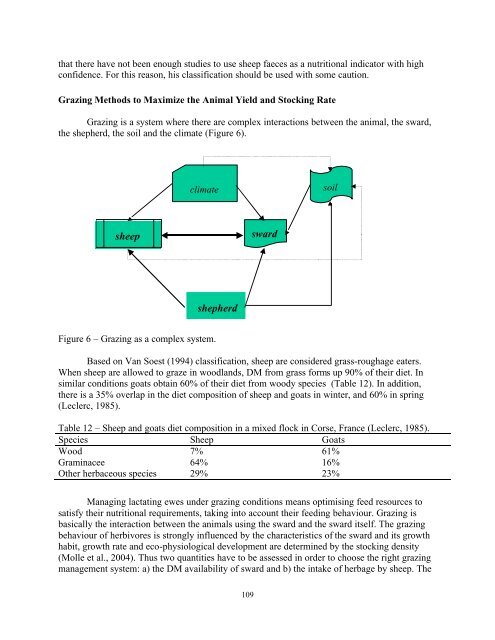Great Lakes Dairy Sheep Symposium - the Department of Animal ...
Great Lakes Dairy Sheep Symposium - the Department of Animal ...
Great Lakes Dairy Sheep Symposium - the Department of Animal ...
Create successful ePaper yourself
Turn your PDF publications into a flip-book with our unique Google optimized e-Paper software.
that <strong>the</strong>re have not been enough studies to use sheep faeces as a nutritional indicator with high<br />
confidence. For this reason, his classification should be used with some caution.<br />
Grazing Methods to Maximize <strong>the</strong> <strong>Animal</strong> Yield and Stocking Rate<br />
Grazing is a system where <strong>the</strong>re are complex interactions between <strong>the</strong> animal, <strong>the</strong> sward,<br />
<strong>the</strong> shepherd, <strong>the</strong> soil and <strong>the</strong> climate (Figure 6).<br />
sheep<br />
climate<br />
Figure 6 – Grazing as a complex system.<br />
shepherd<br />
Based on Van Soest (1994) classification, sheep are considered grass-roughage eaters.<br />
When sheep are allowed to graze in woodlands, DM from grass forms up 90% <strong>of</strong> <strong>the</strong>ir diet. In<br />
similar conditions goats obtain 60% <strong>of</strong> <strong>the</strong>ir diet from woody species (Table 12). In addition,<br />
<strong>the</strong>re is a 35% overlap in <strong>the</strong> diet composition <strong>of</strong> sheep and goats in winter, and 60% in spring<br />
(Leclerc, 1985).<br />
Table 12 – <strong>Sheep</strong> and goats diet composition in a mixed flock in Corse, France (Leclerc, 1985).<br />
Species <strong>Sheep</strong> Goats<br />
Wood 7% 61%<br />
Graminacee 64% 16%<br />
O<strong>the</strong>r herbaceous species 29% 23%<br />
Managing lactating ewes under grazing conditions means optimising feed resources to<br />
satisfy <strong>the</strong>ir nutritional requirements, taking into account <strong>the</strong>ir feeding behaviour. Grazing is<br />
basically <strong>the</strong> interaction between <strong>the</strong> animals using <strong>the</strong> sward and <strong>the</strong> sward itself. The grazing<br />
behaviour <strong>of</strong> herbivores is strongly influenced by <strong>the</strong> characteristics <strong>of</strong> <strong>the</strong> sward and its growth<br />
habit, growth rate and eco-physiological development are determined by <strong>the</strong> stocking density<br />
(Molle et al., 2004). Thus two quantities have to be assessed in order to choose <strong>the</strong> right grazing<br />
management system: a) <strong>the</strong> DM availability <strong>of</strong> sward and b) <strong>the</strong> intake <strong>of</strong> herbage by sheep. The<br />
109<br />
sward<br />
soil
















